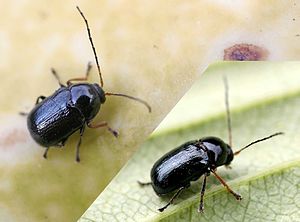Fall beetle
| Fall beetle | ||||||||||||
|---|---|---|---|---|---|---|---|---|---|---|---|---|

|
||||||||||||
| Systematics | ||||||||||||
|
||||||||||||
| Scientific name | ||||||||||||
| Cryptocephalinae | ||||||||||||
| Gyllenhaal , 1813 |

The fall beetles (Cryptocephalinae) are a subfamily of the leaf beetle family (Chrysomelidae). They occur in Europe with 308 species and subspecies.
features
The beetles have a stocky build and usually have a very noticeable shiny metallic or bright color. The pronotum and wing cover are often colored differently. The antennae are long and thread-shaped, the head is directed vertically downwards. The rear edge of the pronotum is toothed. The hips ( coxae ) of the front legs are separated from each other by the attachment of the prothorax .
Way of life
Fall beetles feed on the leaves of their host plants, and more rarely on pollen. Their larvae live in the litter and eat detritus (disintegrated organic substances), usually the fallen leaves of their host plant, or, more rarely, fresh leaves. They live, protected from enemies, in a housing made of excrement and secretion. In case of danger they can completely withdraw into this protective coat. They also pupate in their housing.
Systematic classification
The subfamily of the fall beetle, which is widespread worldwide, comprises 5300 species in 127 genera. It is subdivided into three tribes, which also include the two Clytrinae (now Clytrini ) and Chlamisinae (now Fulcidacini ), which used to be seen as separate subfamilies .
- Cryptocephalini with more than 3500 species occur worldwide. Underneath are:
- Clytrini include more than 1300 species in the Nearctic , Palearctic , Neotropical , Afrotropical , Oriental, and Australis . The greatest biodiversity is found among the Clytrini in South America , Africa and Asia . They hardly exist in the Caribbean or Australia , and are completely absent in New Zealand . The clytrini consist of six sub-branches, the three largest are:
- Fulcidacini , previously called Chlamisini or as a subfamily Chlamisinae, consist of about 400 species in 11 genera. 80% of the species are native to the Neotropic , the remaining fifth lives scattered on all continents except Antarctica .
European species (selection)
- Clytra laeviuscula Ratzeburg , 1837 - Ant bag beetle
- Coptocephala unifasciata ( Scopoli , 1763)
- Cryptocephalus bilineatus ( Linnaeus , 1758) - two-lined fall beetle
- Cryptocephalus bipunctatus ( Linnaeus , 1758) - two-point fall beetle
- Cryptocephalus cordiger ( Linnaeus , 1758) - heart-spotted hooded leaf beetle
- Cryptocephalus flavipes Fabricius , 1781
- Cryptocephalus globicollis
- Cryptocephalus moraei ( Linnaeus , 1758) - Cross-linked fall beetle
- Cryptocephalus nitidus ( Linnaeus , 1758)
- Cryptocephalus ocellatus Drapiez , 1819
- Cryptocephalus parvulus
- Cryptocephalus quinquepunctatus ( Scopoli , 1763) - five-spot drop beetle
- Cryptocephalus sericeus ( Linnaeus , 1758) - silky fall beetle or green-blue fall beetle
- Cryptocephalus trimaculatus Rossi , 1790
- Cryptocephalus violaceus
- Cryptocephalus vittatus Fabricius , 1775 - Banded fall beetle
- Labidostomis longimana
- Labidostomis tridentata
- Macrolenes dentipes
- Pachybrachys hieroglyphicus Laicharting , 1781 - Hieroglyphic spotted beetle
- Smaragdina aurita ( Linnaeus , 1767)
- Tituboea biguttata ( GA Olivier , 1791)
Individual evidence
- ↑ Cryptocephalinae. Fauna Europaea, accessed December 9, 2007 .
- ↑ ML Chamorro: 2.7.5 Chrysomelidae: Cryptocephalinae Gyllenhal 1813. In: RAB Leschen, RG Beutel & JF Lawrence (ed.): Handbook of Zoology. Arthropoda: Insecta. Coleoptera, Beetles. Vol. 3. Morphology and Systematics (Phytophaga). Walter De Gruyter, Berlin-New York 2013 pp. 81–87
- ↑ CG Brown & DJ Funk: Aspects of the natural history of Neochlamisus (Coleoptera: Chrysomelidae): fecal-case-associated life history and behavior, with a method for studying insect constructions. Annals of the Entomological Society of America, 98, 5, pp. 711-725, 2005 doi : 10.1603 / 0013-8746 (2005) 098 [0711: AOTNHO] 2.0.CO; 2
- ↑ D. Erber: Biology of Camptosoma Clytrinae-Cryptocephalinae-Chlamisinae-Lamprosomatinae. In: P. Jolivet, E. Petitpierre & TH Hsiao (Eds.): Biology of Chrysomelidae. Kluwer Academic Publishers, London 1988, pp. 513-552 doi : 10.1007 / 978-94-009-3105-3_30
- ↑ Caroline S. Chaboo, Christopher G. Brown & Daniel J. Funk: Faecal case architecture in the gibbosus species group of Neochlamisus Karren, 1972 (Coleoptera: Chrysomelidae: Cryptocephalinae: Chlamisini). Zoological Journal of the Linnean Society, 152, 2, pp. 315-351, 2008 doi : 10.1111 / j.1096-3642.2007.00343.x
literature
- Jiři Zahradnik, Irmgard Jung, Dieter Jung et al .: Beetles of Central and Northwestern Europe. Parey, Berlin 1985, ISBN 3-490-27118-1 .
- Erber, D. 1988. Biology of Camptosomata Clytrinae - Cryptocephalinae - Chlamisinae - Lamprosomatinae. Pp. 513-552. In: Jolivet, P. et al. (eds.) Biology of Chrysomelidae. Kluwer, Dordrecht.